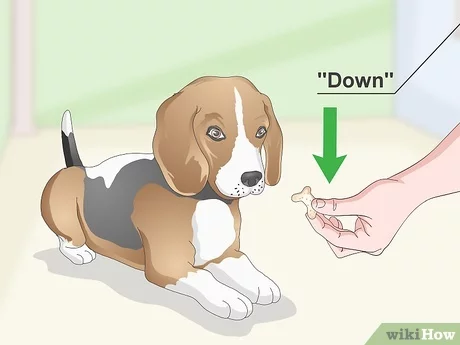Beagles, with their distinctive big brown eyes and adorable floppy ears, are beloved for their playful and affectionate nature. However, training these intelligent yet stubborn hounds can present challenges that may require adjustments in approach and techniques. To help you navigate the training journey successfully, this article will highlight common errors to avoid and provide tips for effective beagle training.

Command Nagging: The Art of Patience and Distraction
One common pitfall is repeating commands incessantly when your beagle ignores them. This approach can inadvertently teach your dog to delay responding, as they learn that persistence eventually pays off. Instead, adopt a strategy that focuses on gaining your dog’s attention and fostering positive associations with commands.
Attract Attention with High-Value Treats
Before issuing a command, use high-value treats (such as chicken or cheese) to attract your beagle’s attention. Once they are paying attention to you, calmly give the command. If they respond correctly, reward them generously. This establishes a positive connection between the command and a desirable outcome.
Using high-value treats not only helps to gain your dog’s attention but also motivates them to listen and follow through with the command. It creates a positive association with training and reinforces good behavior. However, it is essential to use these treats sparingly and only during training sessions to prevent overfeeding and potential weight gain.
Avoid Command Nagging
It can be tempting to repeat a command multiple times when your beagle does not respond immediately. However, this can lead to your dog ignoring the command altogether, as they learn that they do not have to respond until you start nagging. Instead, remain calm and patient, and wait for your dog to respond before giving the command again.
If your beagle continues to ignore the command, try using a different approach or take a break and come back to it later. Remember, training takes time and patience, and nagging will only hinder progress.
Lack of Practice: The Key to Retention and Consistency
Just as we humans need regular practice to master new skills, beagles require consistent reinforcement to retain commands. Once your dog initially learns a command, don’t assume they have it down pat and move on to the next one. Dedicate 5-10 minutes daily for new tricks and old command reinforcement.
Daily Training Sessions
Consistency is key when it comes to training beagles. Dedicate a specific time each day for training sessions, and stick to it. This will help your dog understand that this is a routine and will make them more receptive to learning.
During these sessions, focus on one command at a time and repeat it multiple times. Be patient and reward your dog when they respond correctly. As they become more proficient, gradually increase the difficulty level by adding distractions or increasing the distance between you and your dog.
Reinforce Old Commands
It is essential to continue practicing old commands even after your beagle has mastered them. This helps to prevent forgetting and reinforces good behavior. It also allows you to maintain consistency in your dog’s training and prevents regression.
Reinforcing old commands can also be a fun way to bond with your dog. You can incorporate them into playtime or daily activities, such as asking your dog to sit before giving them their food or asking them to stay while you open the door.
Negative Command Association: Avoid Using Commands in Negative Situations
Beagles are sensitive dogs, and they can easily associate negative experiences with certain commands. For example, if you use the “come” command when taking your dog to the vet, they may develop an aversion to it. This can make it challenging to get them to come to you in other situations.
To avoid this, try to use different commands in negative situations or use a neutral tone when giving commands. This will prevent your dog from developing negative associations with certain commands and make training more effective.
Unrealistic Expectations: Training Requires Patience and Repetition
It is essential to have realistic expectations when it comes to training your beagle. While they are intelligent dogs, they can also be stubborn and may take longer to learn certain commands. Do not expect instant results or obedience within a short timeframe.
Training takes time, patience, and consistency. It is crucial to remain calm and positive during training sessions and avoid getting frustrated or angry. This can create a negative environment and hinder your dog’s progress.
Beagles also have a short attention span, so it is essential to keep training sessions short and engaging. If your dog seems disinterested or distracted, take a break and try again later.
Low-Value Treats: Use High-Value Treats as Rewards
As mentioned earlier, using high-value treats during training sessions can be highly effective. However, it is equally important to avoid using low-value treats as rewards. These can include regular dog biscuits or kibble.
Using low-value treats may not motivate your dog to listen and follow through with commands. They may also become bored with the training session and lose interest. It is best to save these treats for everyday snacking and use high-value treats exclusively for training purposes.
Adult Beagle Neglect: Continue Training Adult Beagles
Many people assume that once a dog reaches adulthood, they no longer need training. However, this is not the case for beagles. Just like puppies, adult beagles require mental stimulation and continued training to correct bad behaviors and maintain good behavior.
If you adopt an adult beagle, it is essential to continue their training and reinforce good behavior. This will help them adjust to their new home and prevent any potential behavioral issues.
Seeking Help: Consult a Professional Dog Trainer
If you are experiencing difficulties with training your beagle, do not hesitate to seek help from a professional dog trainer. They have the knowledge and experience to help you overcome any challenges and make training more effective.
When choosing a trainer, it is crucial to find one who uses positive reinforcement methods. These methods focus on rewarding good behavior rather than punishing bad behavior, which can harm the dog’s well-being.
Conclusion
Training a beagle can be a challenging but rewarding experience. By avoiding common errors such as command nagging, lack of practice, negative command association, and having unrealistic expectations, you can make the training journey smoother and more effective.
Remember to use high-value treats as rewards, continue training adult beagles, and seek help from a professional trainer if needed. With patience, consistency, and positive reinforcement, you can successfully train your beagle and strengthen your bond with them.






